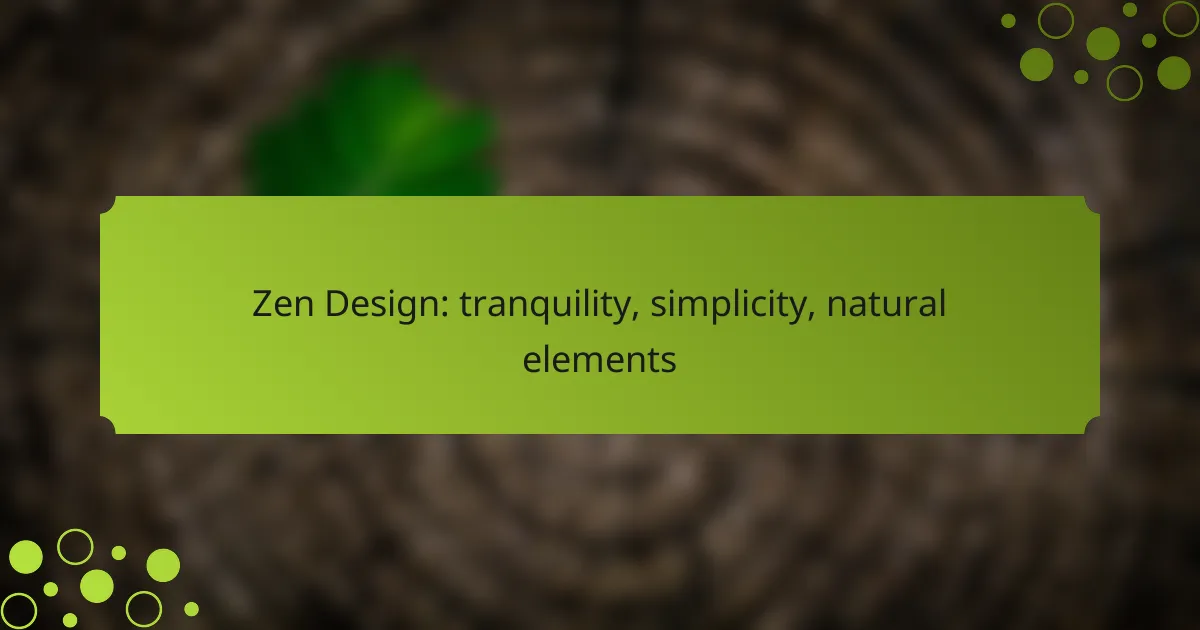Zen design focuses on cultivating tranquility and mindfulness through simplicity and the integration of natural elements. By utilizing natural materials, open spaces, and calming colors, it creates serene environments that enhance well-being and promote emotional balance. This design philosophy emphasizes harmony and a deep connection to nature, fostering mental clarity in our living spaces.

How to achieve Zen design in Australian homes?
Achieving Zen design in Australian homes involves creating a serene environment through simplicity, natural elements, and a focus on tranquility. Key strategies include using natural materials, emphasizing open spaces, and incorporating calming colors.
Incorporate natural materials
Using natural materials like wood, stone, and bamboo can enhance the Zen aesthetic in your home. These elements not only add warmth but also connect the interior with the surrounding environment, promoting a sense of peace.
Consider sourcing locally available materials to support sustainability and reduce your carbon footprint. For example, Australian hardwoods such as Tasmanian Oak or Blackbutt can be excellent choices for flooring and furniture.
Emphasize open spaces
Open spaces are crucial in Zen design as they promote a sense of freedom and calm. Aim for a layout that minimizes clutter and allows for easy movement throughout the home.
When designing your space, consider removing unnecessary walls or using sliding doors to create a seamless flow between indoor and outdoor areas. This approach can enhance natural light and improve the overall ambiance.
Utilize calming color palettes
Calming color palettes are essential for achieving a Zen atmosphere. Soft, neutral tones like whites, beiges, and gentle greens can create a soothing backdrop that encourages relaxation.
Incorporate these colors through paint, furnishings, and decor. For instance, a light sage green wall can evoke a sense of tranquility while complementing natural wood accents.
Integrate indoor plants
Indoor plants play a vital role in Zen design by bringing nature indoors and improving air quality. Choose low-maintenance plants like succulents, ferns, or peace lilies to enhance your space without overwhelming it.
Position plants in areas where they can thrive, such as near windows or in well-lit rooms. Grouping plants in varying heights can create visual interest while maintaining a serene environment.
Focus on minimalism
Minimalism is a key principle of Zen design, emphasizing the importance of “less is more.” Aim to declutter your space by keeping only essential items that bring joy or serve a purpose.
Consider implementing storage solutions that hide away non-essential items, allowing surfaces to remain clear. This approach not only enhances visual appeal but also fosters a peaceful mindset.

What are the key principles of Zen design?
Zen design is centered around creating spaces that promote tranquility and mindfulness through simplicity and natural elements. The key principles include balance and harmony, an emphasis on simplicity, and a strong connection to nature.
Balance and harmony
Balance and harmony in Zen design refer to the careful arrangement of elements to create a sense of peace. This can be achieved by distributing visual weight evenly across a space, ensuring that no single element overwhelms another.
To create balance, consider using symmetrical arrangements or a mix of symmetrical and asymmetrical designs. For example, placing a large piece of furniture on one side of a room can be balanced by smaller accessories on the opposite side.
Emphasis on simplicity
Simplicity is a core tenet of Zen design, focusing on minimalism to reduce distractions and promote clarity. This involves using a limited color palette, clean lines, and functional furnishings that serve a purpose without unnecessary embellishments.
When designing a space, aim to declutter and keep only essential items. A good rule of thumb is to have one or two focal points in a room, allowing the eye to rest and the mind to relax.
Connection to nature
A strong connection to nature is vital in Zen design, often achieved through the use of natural materials and elements. Incorporating wood, stone, and plants can create a calming atmosphere that reflects the tranquility of the outdoors.
To enhance this connection, consider using large windows to bring in natural light or creating indoor gardens. Even small touches, like adding potted plants or natural textiles, can significantly impact the overall feel of a space.

How can Zen design improve well-being?
Zen design enhances well-being by fostering a serene environment that encourages mindfulness and tranquility. By incorporating simplicity and natural elements, it creates spaces that promote mental clarity and emotional balance.
Reduces stress levels
Zen design significantly reduces stress levels by eliminating clutter and creating a calming atmosphere. Natural materials, soft colors, and open spaces contribute to a sense of peace, allowing individuals to unwind and recharge.
To maximize stress reduction, consider using elements like plants, water features, or natural light. These features not only beautify a space but also have been shown to lower cortisol levels, which are associated with stress.
Enhances focus and productivity
By minimizing distractions, Zen design enhances focus and productivity. A clean, organized environment allows for better concentration on tasks, leading to increased efficiency and creativity.
Incorporating dedicated workspaces with natural light and ergonomic furniture can further boost productivity. Aim for a balance of functionality and tranquility to create an ideal working environment.
Promotes relaxation
Zen design promotes relaxation through its emphasis on simplicity and natural elements. Spaces designed with soft textures, soothing colors, and ambient lighting encourage a sense of calm and well-being.
To create a relaxing environment, consider adding comfortable seating areas, calming scents, and gentle sounds, such as soft music or nature sounds. These elements can transform a space into a sanctuary for rest and rejuvenation.

What are the best materials for Zen design?
The best materials for Zen design emphasize tranquility, simplicity, and a connection to nature. Key materials include bamboo, wood, stone, clay, and natural fibers, each contributing to a serene and harmonious environment.
Bamboo and wood
Bamboo and wood are popular choices in Zen design due to their natural aesthetic and sustainability. Bamboo is particularly valued for its rapid growth and strength, making it an eco-friendly option. Wood, whether from hardwoods or softwoods, adds warmth and texture to spaces.
When selecting bamboo or wood, consider finishes that enhance their natural beauty without overpowering the simplicity of the design. Avoid synthetic coatings that may detract from the organic feel.
Stone and clay
Stone and clay are foundational materials in Zen design, evoking a sense of permanence and grounding. Natural stone, such as granite or slate, can be used for flooring or decorative elements, while clay is often shaped into pottery or tiles.
Incorporating stone and clay can create a tactile experience that connects occupants to the earth. Choose unglazed clay for a more rustic look, and ensure that any stone used is sourced responsibly to maintain environmental integrity.
Natural fibers
Natural fibers, including cotton, linen, and jute, are essential for soft furnishings in Zen spaces. These materials promote comfort and can be used for rugs, cushions, and curtains, enhancing the overall tranquility of the environment.
When selecting natural fibers, opt for organic options that are free from harsh chemicals. This not only supports sustainability but also contributes to a healthier indoor atmosphere. Look for items that are easy to maintain and durable to withstand everyday use.

How to create a Zen garden?
Creating a Zen garden involves designing a tranquil space that emphasizes simplicity and natural elements. Key components include selecting suitable plants, incorporating water features, and using gravel and rocks to enhance the serene atmosphere.
Choose appropriate plants
Selecting the right plants is crucial for a Zen garden, as they contribute to the overall tranquility. Opt for low-maintenance species such as bamboo, ferns, or moss that thrive in your local climate.
Consider the colors and textures of the plants. Greens and subtle blooms promote calmness, while varying heights can create visual interest without overwhelming the space. Aim for a balanced arrangement that feels harmonious.
Incorporate water features
Water features add a soothing element to a Zen garden, enhancing the sense of peace. Simple options include small ponds, fountains, or even a dry stream bed that mimics the flow of water.
When designing, ensure the water feature is proportionate to the garden size. The sound of flowing water can be calming, so consider placement to maximize auditory enjoyment while maintaining visual balance.
Design with gravel and rocks
Gravel and rocks are essential materials in a Zen garden, representing the earth and providing structure. Use fine gravel to create raked patterns that symbolize water ripples, promoting a sense of movement.
Incorporate larger rocks as focal points or boundaries. Choose stones that are naturally shaped and vary in size to create visual interest. Avoid clutter; simplicity is key to maintaining a peaceful environment.

What are the benefits of Zen design in office spaces?
Zen design in office spaces promotes tranquility, simplicity, and the use of natural elements, leading to a more harmonious work environment. This approach can enhance focus, reduce stress, and improve overall productivity among employees.
Improves employee morale
Zen design significantly boosts employee morale by creating a calming atmosphere that fosters well-being. Natural light, plants, and minimalist decor help reduce stress and anxiety, making employees feel more at ease in their workspace.
Incorporating elements like water features or soft colors can further enhance this effect. Employees are more likely to feel motivated and engaged in a serene environment, leading to higher job satisfaction and lower turnover rates.
To implement Zen design effectively, consider conducting employee surveys to understand their preferences for workspace aesthetics. Regularly updating the office with natural elements or creating quiet zones can also contribute to sustained morale improvements.
